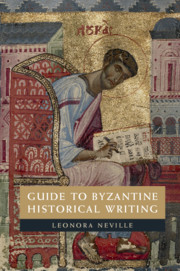Book contents
- Frontmatter
- Dedication
- Contents
- Acknowledgments
- Introduction
- Byzantine Historical Texts
- 1 Theophylakt Simokatta
- 2 Paschal Chronicle
- 3 George Synkellos
- 4 Chronicle of Theophanes
- 5 Patriarch Nikephoros
- 6 Scriptor Incertus de Leo V
- 7 Chronicle of 811
- 8 Megas Chronographos
- 9 George the Monk
- 10 Peter of Alexandria
- 11 Genesios
- 12 Theophanes Continuatus
- 13 Constantinian Excerpts
- 14 John Kaminiates
- 15 Symeon the Logothete
- 16 Leo the Deacon
- 17 Chronicle of Monemvasia
- 18 Chronicon Bruxellense
- 19 Psellos
- 20 John Xiphilinos
- 21 Michael Attaleiates
- 22 John Skylitzes and Scylitzes Continuatus
- 23 George Kedrenos
- 24 Nikephoros Bryennios
- 25 Anna Komnene
- 26 John Kinnamos
- 27 John Zonaras
- 28 Constantine Manasses
- 29 Michael Glykas
- 30 Eustathios of Thessaloniki
- 31 Joel
- 32 Niketas Choniates
- 33 George Akropolites
- 34 Theodore Skoutariotes
- 35 George Pachymeres
- 36 Nikephoros Gregoras
- 37 Ephraim
- 38 Constantine Akropolites the Grand Logothete
- 39 Chronicle of Morea
- 40 Nikephoros Kallistos Xanthopoulos
- 41 John VI Kantakouzenos
- 42 Michael Panaretos
- 43 Chronicle of Ioannina
- 44 Chronicle of Tocco
- 45 John Kananos
- 46 John Anagnostes
- 47 Leontios Machairas
- 48 Sylvester Syropoulos
- 49 Doukas
- 50 George Sphrantzes
- 51 Michael Kritovoulos
- 52 Laonikos Chalkokondyles
- Appendix A Time Periods Covered in the Histories
- Appendix B Timeline of Authors’ Lives
31 - Joel
from Byzantine Historical Texts
Published online by Cambridge University Press: 14 June 2018
- Frontmatter
- Dedication
- Contents
- Acknowledgments
- Introduction
- Byzantine Historical Texts
- 1 Theophylakt Simokatta
- 2 Paschal Chronicle
- 3 George Synkellos
- 4 Chronicle of Theophanes
- 5 Patriarch Nikephoros
- 6 Scriptor Incertus de Leo V
- 7 Chronicle of 811
- 8 Megas Chronographos
- 9 George the Monk
- 10 Peter of Alexandria
- 11 Genesios
- 12 Theophanes Continuatus
- 13 Constantinian Excerpts
- 14 John Kaminiates
- 15 Symeon the Logothete
- 16 Leo the Deacon
- 17 Chronicle of Monemvasia
- 18 Chronicon Bruxellense
- 19 Psellos
- 20 John Xiphilinos
- 21 Michael Attaleiates
- 22 John Skylitzes and Scylitzes Continuatus
- 23 George Kedrenos
- 24 Nikephoros Bryennios
- 25 Anna Komnene
- 26 John Kinnamos
- 27 John Zonaras
- 28 Constantine Manasses
- 29 Michael Glykas
- 30 Eustathios of Thessaloniki
- 31 Joel
- 32 Niketas Choniates
- 33 George Akropolites
- 34 Theodore Skoutariotes
- 35 George Pachymeres
- 36 Nikephoros Gregoras
- 37 Ephraim
- 38 Constantine Akropolites the Grand Logothete
- 39 Chronicle of Morea
- 40 Nikephoros Kallistos Xanthopoulos
- 41 John VI Kantakouzenos
- 42 Michael Panaretos
- 43 Chronicle of Ioannina
- 44 Chronicle of Tocco
- 45 John Kananos
- 46 John Anagnostes
- 47 Leontios Machairas
- 48 Sylvester Syropoulos
- 49 Doukas
- 50 George Sphrantzes
- 51 Michael Kritovoulos
- 52 Laonikos Chalkokondyles
- Appendix A Time Periods Covered in the Histories
- Appendix B Timeline of Authors’ Lives
Summary
A chronicle surviving in four manuscripts is attributed to Joel. In three of the manuscripts the Chronographia en synopsei (Summary Chronicle) of Joel covers from Adam to the capture of Constantinople in 1204. In a fourth manuscript, the narrative extends to 1258. This is a brief chronicle (1614 lines in Iadevaia's edition of the short version) that lists rulers in order, with information on the length of their reigns. It integrates the reigns of select Babylonian, Persian, Macedonain, and Seleucid rulers with those of biblical patriarchs and rulers. From Julius Caesar onward, the chronicle follows the line of Roman emperors.
In the final lines of the short version, the author lists Andronikos Komnenos's murder of Alexios II, Isaac Angelos's murder of Andronikos, Alexios III Angelos's blinding of Isaac, Aleixos IV's exile of Alexios III, and Alexios V's murder of Alexios IV. He then concludes: “Alas for these things that Christians have done to Christians! How could justice remain silent and not hand us over to captivity and destruction? Which, indeed happened, and for such wickedness the illustrious city of Constantine was given to the Italians.”
Given the way this text ends, with the sack of Constantinople in 1204, it was most likely written in the thirteenth century – before the re- conquest in 1261. The style in which emperors are noted changes after Nikephoros Botaneiates (1078– 1081), leading Tsolak ē s to argue that a first version of the text was composed in the reign of Alexios Komnenos (1081– 1118) and then extended to 1204. The version in the Iviron manuscript that extends to 1258 apparently was made before the reconquest of Constantinople in 1261.
The author appears to have used the work of George the Monk, Skylitzes, Scylitzes Continuatus, and George Kedrenos. Dean Sakel suggests that the Chronicle of Joel may have been used as a source for the Chronicle of 1570.
- Type
- Chapter
- Information
- Guide to Byzantine Historical Writing , pp. 216 - 218Publisher: Cambridge University PressPrint publication year: 2018

